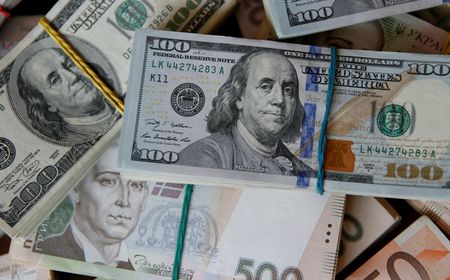By Karin Strohecker and Olena Harmash
LONDON (Reuters) -Ukraine is starting to consider a shift away from the U.S. dollar, possibly linking its currency more closely to the euro amid the splintering of global trade and its growing ties to Europe, Central Bank Governor Andriy Pyshnyi told Reuters.
Potential accession to the European Union, a “strengthening of the EU’s role in ensuring our defence capabilities, greater volatility in global markets, and the probability of global-trade fragmentation,” are forcing the central bank to review whether the euro should be the reference currency for Ukraine’s hryvnia instead of the dollar, Pyshnyi said in emailed remarks.
“This work is complex and requires high-quality, versatile preparation,” Pyshnyi added, in the most direct comments by a Ukrainian official on a possible shift.
The dollar dominates international trade and accounts for the majority of global reserves. Major economies including Saudi Arabia and Hong Kong peg their currencies to the dollar.
But under President Donald Trump, the U.S. has unleashed a trade war by introducing what could be the highest tariffs in a century, a move that has prompted some observers to question the future role of the dollar as global reserve currency.
Now in the fourth year of fighting an invasion by Russia, Ukraine also saw Trump temporarily cut off some military assistance to the country.
European leaders, including from the EU, have vowed to strengthen Kyiv’s military to ensure it can be the cornerstone of future security in Ukraine but progress has been difficult.
Phoenix Kalen, global head of emerging markets research at Societe Generale, said Ukraine’s deliberations matched a wider pattern of states trying to rethink how they align their geopolitical, security and trade ties in a shifting world order.
“Certainly in Ukraine’s case, its destiny is tied to Europe and European defence,” Kalen said. “From that angle, all the economic and political aspirations are still going to be very much tied to the euro, so I think it makes sense for many reasons why they would want to consider this shift.”
Meanwhile, Ukraine struck an agreement that gives the United States preferential access to new Ukrainian mineral deals and which funds investment in the nation’s reconstruction.
Since Trump’s return to the White House, the greenback is down more than 9% against a basket of major currencies as investors pull back from owning U.S. assets.
Some experts warn against associating the strength of the dollar to its reserve-currency status. Yet historically, dollar holdings have been linked to security alliances and military ties to Washington.
Transactions with the U.S. dollar continue to dominate all segments of the FX market, said Pyshnyi, but the share of euro-denominated transactions has been rising in most segments though “so far moderately.” He did not elaborate.
The U.S. Treasury did not respond to a request for comment.
EU AMBITIONS
Ukraine launched the hryvnia in 1996, and over the decades it has used the dollar as the reference currency.
Immediately after Russia’s invasion in February 2022, the central bank imposed capital controls and pegged the hryvnia at an official rate of about 29 to the U.S. dollar. Ukraine was forced to devalue later due to a buildup of fiscal imbalances.
In October 2023, the central bank moved from a firm peg to a managed exchange-rate regime that uses the U.S. dollar as the reference – the gauge to measure FX interventions and for smoothing fluctuations in the exchange rate.
The EU opened membership talks with Ukraine and Moldova nearly a year ago, although a long and tough road lies ahead before it can join the bloc.
The head of the European Commission, Ursula von der Leyen, said in February that Ukraine could be join by 2030 provided it continued to enact reforms of its political and judicial system at the current pace.
In preparation, Moldova switched its reference currency for the Moldovan lei to the euro from the dollar on Jan. 2.
A revival of investment and consumer activity thanks to closer links with Europe and economic normalisation would help Ukraine’s economic growth pick up slightly over the next two years to 3.7-3.9%, Pyshnyi said, though much of the economic trajectory depends on how the conflict develops.
“A quick end to the war would clearly be a positive scenario with good economic outcomes if it were to incorporate security guarantees for Ukraine,” he said.
“Nevertheless, it’s crucial to acknowledge that the economic benefits of ending the war would likely take time to fully materialize.”
Ukraine is relying on external financing to help fund the war effort.
Pyshnyi said he expected $55 billion this year, which would not only cover the budget deficit but also be used to set aside a public-finance reserve for the coming years, when aid volumes were likely to start declining.
“We project Ukraine will receive about $17 billion in 2026 and $15 billion in 2027,” said Pyshnyi.
(Reporting by Karin Strohecker in London and Olena Harmash in Kyiv. Editing by Elisa Martinuzzi, Matthew Lewis and Gareth Jones)










